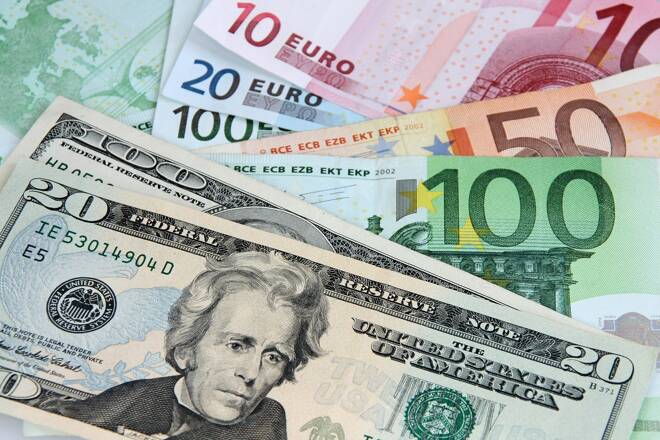Advertisement
Advertisement
EUR/USD Weekly Forecast: Eurozone Inflation, the US Jobs Report, and the Fed
By:
Key economic indicators from the euro area and the US could influence ECB and Fed policy moves for Q1 and dictate near-term trends for the EUR/USD.
Highlights
- The EUR/USD declined by 0.40% in the week ending January 26, closing the week at $1.08531.
- Robust US economic indicators and rising threats to a Eurozone recession impacted.
- The German economy, euro area inflation, the US Jobs Report, and the Fed need consideration in the week ahead.
Weekly Overview of the EUR/USD in the Week Ending January 26, 2024
In the week ending on January 26, the EUR/USD declined by 0.40% to $1.08531. The EUR/USD rose to a Wednesday high of $1.09323 before falling to a Friday low of $1.08128.
EUR/USD Analysis: Inflation and the German Economy in Focus
On Tuesday, Q4 GDP numbers for France, Germany, and the Eurozone will garner investor interest. The German economy has raised the threat of a Eurozone recession. Weaker-than-expected GDP numbers could send more recessionary signals.
Economists forecast the Eurozone economy to contract by 0.1% quarter-on-quarter in Q4.
On Wednesday, the German economy will be under the spotlight. Inflation, retail sales, and unemployment figures need consideration. Recent GfK Consumer Climate numbers for Germany painted a grim picture of the German economy. A pickup in inflationary pressures and a further slide in retail sales could impact the wider Eurozone economy.
Economists forecast retail sales to increase by 0.8% in December after sliding by 2.5% in November. Significantly, economists expect the annual inflation rate to soften from 3.7% to 3.3% in January.
Other stats include French inflation figures that will also move the dial.
On Thursday, euro area Manufacturing PMIs and Eurozone inflation figures wrap up a busy week on the euro area economic calendar. The Italian Manufacturing PMI and finalized PMIs from Germany and the Eurozone will draw interest. A downward revision to the Eurozone preliminary PMI could impact demand for the EUR/USD.
However, investors must consider sub-components, including prices, job creation, and supply chains.
While the PMIs will influence, preliminary Eurozone inflation figures will impact the EUR/USD more. Sticky inflation would support the ECB’s stance on interest rates. On Thursday, ECB President Lagarde warned it was too soon to discuss interest rate cuts.
Beyond the numbers, ECB commentary also needs monitoring. ECB Chief Economist Philip Lane (Tues/Thurs), Vice President Luis de Guindos (Mon), and Executive Board member Anneli Tuominen (Tues) are on the calendar to speak.
US Dollar Update: Consumer Sentiment, the Labor Market, and the Fed
On Tuesday, consumer confidence and JOLTs Job Openings warrant investor attention. An upward trend in US consumer confidence and steady job openings could reduce bets on a March Fed rate cut.
Significantly, economists forecast the CB Consumer Confidence Index to increase from 110.7 to 115.0 in January. Economists predict JOLT Job Openings to fall from 8.79 million to 8.75 million in December.
Tight labor market conditions support wage growth and disposable income. Upward trends in disposable income and consumer confidence could fuel consumer spending and demand-driven inflation. A higher-for-longer Fed rate path could curb consumer spending and dampen demand-driven inflation.
On Wednesday, ADP employment figures for January need consideration. A larger-than-expected rise in employment could influence the Fed rate path. Economists forecast the ADP to report a 135k increase in employment after rising by 164k in December.
However, the Fed interest rate decision, Rate Statement, and Press Conference will have more impact. The markets expect the Fed to leave interest rates unchanged at 5.50%. Forward guidance on inflation, the economy, and interest rates needs consideration.
US labor market and manufacturing sector data will be in focus on Thursday. The labor market numbers will likely have more impact. Tight labor market conditions could raise expectations of an upbeat US Jobs Report.
On Friday, the US Jobs Report will garner investor interest. Wages, nonfarm payrolls, and the US unemployment rate could move the dial. Upward trends in wages and a steady unemployment rate would fuel consumer spending.
Economists forecast the US unemployment rate to rise from 3.7% to 3.8%. Significantly, economists expect average hourly earnings to increase by 4.1% year-over-year in January. In December, average hourly earnings increased by 4.1% year-over-year.
Short-Term Forecast:
The near-term trends for EUR/USD hinge on euro area inflation, the US labor market, and the Fed. Tight US labor market conditions and a hawkish Fed amidst softer euro area inflation figures could tilt monetary policy divergence toward the US dollar.
EUR/USD Price Action
Daily Chart
The EUR/USD sat below the 50-day EMA while holding above the 200-day, sending bearish near-term but bullish longer-term price signals.
A EUR/USD break above the 50-day EMA would support a move to the $1.09294 resistance level. A EUR/USD move through the $1.09294 resistance level would give the bulls a run at the $1.10 handle.
The focal points include euro area inflation figures, the US labor market, and the Fed interest rate decision.
However, a break below the 200-day EMA and the $1.07838 support level would support a fall through the $1.07 handle.
The 14-period Daily RSI at 42.25 indicates a EUR/USD fall through the $1.07838 support level before entering oversold territory.
4-Hour Chart
The EUR/USD remained below the 50-day and 200-day EMAs, affirming bearish price signals.
A EUR/USD breakout from the 50-day EMA would support a move to the 200-day EMA and $1.09294 resistance level. A break above the $1.09294 resistance level would bring the $1.10 handle into play.
However, a break below the $1.07838 support level would support a fall through the $1.07 handle.
The 14-period 4-Hourly RSI at 44.84 suggests a EUR/USD fall through the $1.07838 support level before entering oversold territory.
About the Author
Bob Masonauthor
With over 28 years of experience in the financial industry, Bob has worked with various global rating agencies and multinational banks. Currently he is covering currencies, commodities, alternative asset classes and global equities, focusing mostly on European and Asian markets.
Advertisement
